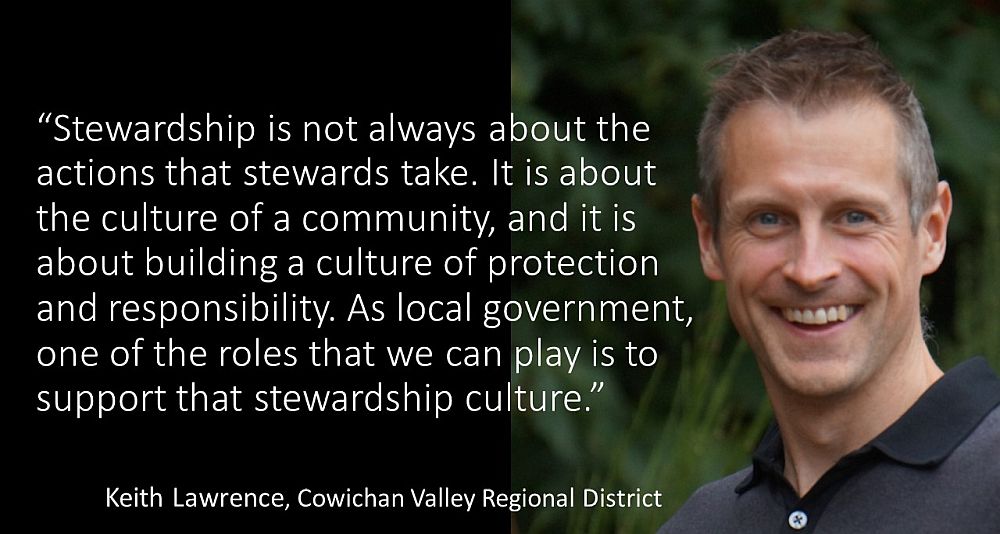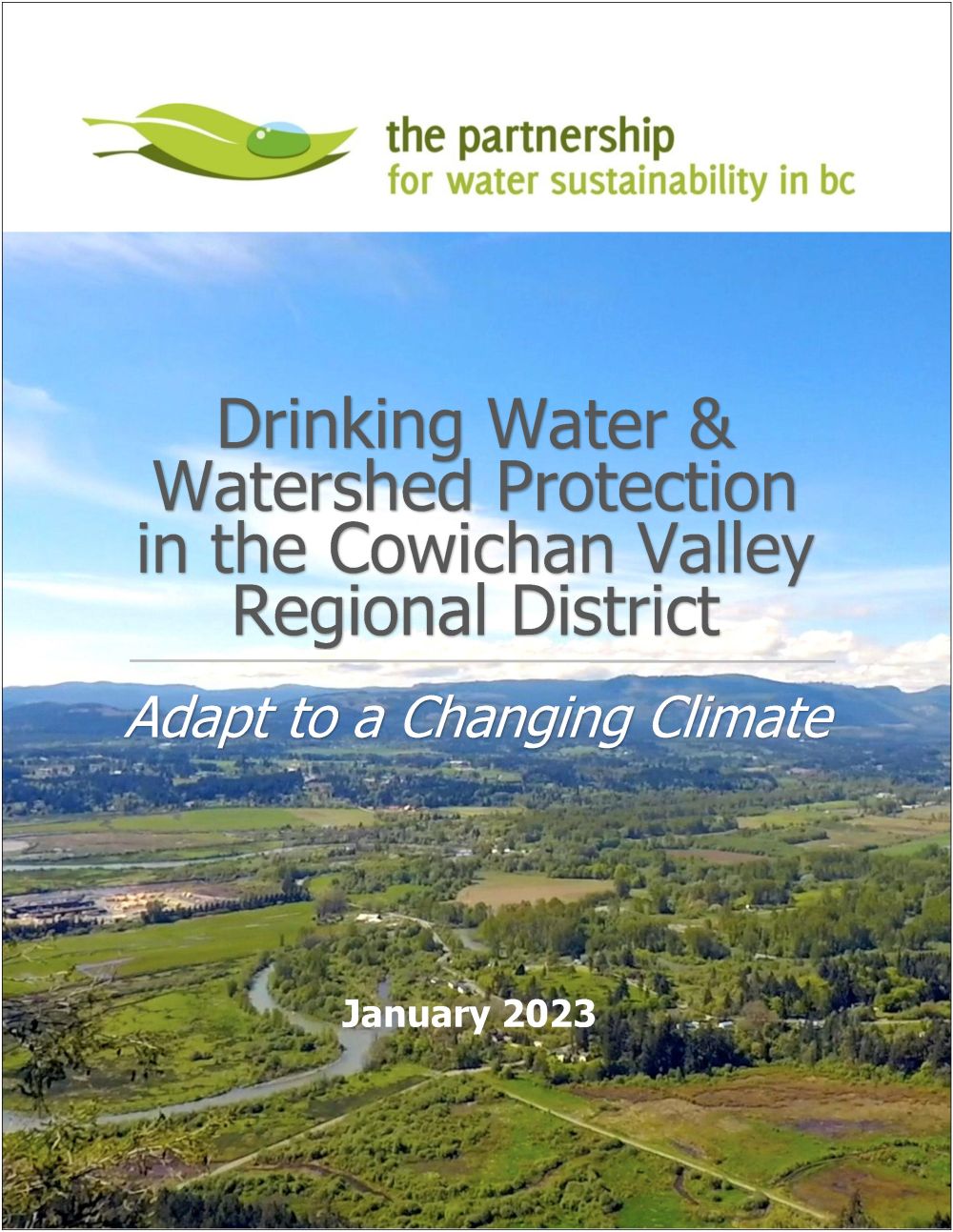ADAPTING TO FLOODS AND DROUGHTS IN THE COWICHAN REGION: “Being part of the inter-regional collaborative network helps us reinforce our long-term strategies. These are necessary to respond to climate threats which are projected to be long-term in duration and changing over the long-term,” stated Keith Lawrence of the Cowichan Valley Regional District
Note to Reader:
Waterbucket eNews celebrates the leadership of individuals and organizations who are guided by the Living Water Smart vision. The edition published on January 31, 2023 publicized the Stories of Inter-Regional Collaboration Series. The first in the series tells the story of the Cowichan Region Drinking Water and Watershed Protection Program.

Adapting to floods and droughts in the Cowichan region
The Partnership for Water Sustainability now has a multi-decade history under the Water Sustainability Action Plan umbrella. This allows us to reflect on both oral and written history, including the context that has informed our collective actions and thus shaped the journey that we are on together.
In 2012, for example, the Partnership asked five Regional Boards — Cowichan Valley, Nanaimo Region, Comox Valley, Capital Region, and Metro Vancouver — to endorse and actively support inter-governmental and inter-regional collaboration through a program that leverages more with the same resources. And so, the Georgia Basin Inter-Regional Education Initiative (IREI) was launched.
Everyone learns through stories, and this is how the Partnership hopes to inspire readers. Today, the Partnership is releasing the first in the Stories of Inter-Regional Collaboration Series. The series is about the IREI and shines the spotlight on the local government champions who are committed to the long-term wellbeing of their communities.
These ‘stories behind the stories’ are weaved from conversational interviews and the resources in the Partnership archives. Stories provide insight into the actions of local government thought leaders. Comprehensive in scope, the series documents a shared history. The stories in the series are not technical reports, although they are founded on technical concepts and understanding.

One Region One Water
The first in the series features the Cowichan Region and tells the story of the Drinking Water and Watershed Protection Program. This regional service is tasked with helping to protect the region’s water resources. The One Water One Region strategy sets out the programs, goal, objectives, program areas, priority actions and guiding principles for delivery.
IREI sessions have allowed me to meet my peers in neighbouring jurisdictions, to check in with each other on validating new approaches for addressing threats to water resources. But also, to ensure that in some cases we might already be on the right path to getting ready for climate threats and impacts,” reports Keith Lawrence of the Cowichan Valley Regional District.
In the story behind the story that follows, we feature quotable quotes by Keith Lawrence and Clayton Postings. They look back to see ahead.

DOWNLOAD A COPY: https://waterbucket.ca/viw/wp-content/uploads/sites/10/2023/01/IREI_Story-of-Cowichan-Region-DWWP_Jan-2023.pdf
EDITOR’S PERSPECTIVE / CONTEXT FOR BUSY READER
“In October 2018, Cowichan electors passed a referendum, by a decisive 58% in favour, to implement the Drinking Water & Watershed Protection regional service. Constructed over decades, the DWWP foundation is solid. The decision to go with the “service function model” was an unforeseen outcome of a Regional Surface and Groundwater Management and Governance Study, completed in 2015. Keith Lawrence led the governance study,” stated Kim Stephens, Waterbucket eNews Editor and Partnership Executive Director.
“Powered by collaboration, the DWWP is the platform for a building blocks process that is ongoing….to achieve the Cowichan region’s water sustainability mission. The DWWP service addresses longstanding surface and groundwater concerns. Implementation, however, is proceeding more slowly than anticipated. This is due to multiple competing demands which result in shifting priorities.”
Future Resiliency of the Cowichan Region
“The influence of the Our River, Our Future Symposium, held in 1995, has rippled through time. It set in motion the processes that led, for example, to development of the Cowichan Basin Water Management Plan. Issues and concerns that were the catalyst for the 1995 forum are front-and-centre three decades later, and with heightened urgency.”
“The Cowichan experience reminds us that the journey must be measured in terms of decades rather than years. One can only realistically judge progress by looking back to assess how far one has travelled. Hence, essential ingredients for mission success are intergenerational commitment and oral history. They go hand in hand.”

STORY BEHIND THE STORY: Adaptation to a Changing Climate in the Cowichan Region
“Early in my career, working with agencies across Western Canada gave me an appreciation for the urgent need for collaboration between organizations. When I joined CVRD in mid-2013, I had a strong sense that this would be a place where I could work in a more collaborative setting,” states Keith Lawrence, CVRD Environmental Services.
“There was a willingness to foster a collaborative framework between partnering organizations so that together we can respond to climate threats to our water resources.”
Engagement of community through stewardship
“The Cowichan River watershed is a great example of community involvement. Given the number of organizations, one needs to create a mind map to understand it, because the stewardship network is an ecosystem in and of itself.
“It was incredibly valuable to be part of the whole water governance program, to convene all the various partnering organizations, and to listen to the various water governance challenges that were occurring across the region, and to be able to synthesize common problem statements as well as actions which need to be in place.”
“Every time we would have workshops and forums that brought together folks that were all on the same page — that we need to act, that we need to develop plans and strategies to respond to the impacts which we know are only going to increase — there was an energy in the room. At the end of the day, folks were willing to commit to the solutions.”
“In some other watersheds, however, there may be nobody engaged in water resource stewardship. Why is it different in one community versus another? Thinking more broadly, how do we enhance a spirit of stewardship everywhere? How do we enhance that responsibility that people everywhere can have towards the watershed that they live in, work in, and play in?”
“Our watersheds have been stewarded for thousands of years by First Nations. We can continue to steward them for thousands of years into the future. But we need to be receptive, and we need to listen to each other and to the lessons that we can learn from our First Nations partners about how that stewardship is accomplished.”
Absorb the wisdom, harness the energy
“We work with all of these partners throughout the region, and it is about being able to harness that collective wisdom and those oral histories as well. So, it is up to each one of us in local government to maintain that energy and deliver the oral history in other settings to inform other audiences who may not yet have a shared understanding of the concerns and hopes for our watersheds.”
“For example, while we are experiencing extreme heat waves, folks may be glad to have warmer water in our lakes for recreation. However, they may not be aware that the higher water temperatures are harmful for aquatic life. When we are delivering our messages, it is important to be aware of this lack of shared understanding. It means we need to innovate in terms of our communication approaches,” concludes Keith Lawrence.

Intergenerational baton for DWWP has been passed to Clayton Postings
Clayton Postings joined the CVRD in May 2022 as General Manager of Strategic Services. His portfolio encompasses the DWWP and Emergency Services Management. Clayton’s learning curve has been steep as he had to absorb and make sense of am immense amount of work that has been completed over decades. His reflections provide relevant context for what it means in practice to look back to see ahead.
“Already I see that understanding how partnerships and relationships work in the Cowichan region is key to moving the DWWP forward. There is lots for me to learn. And I have learned a lot. But I also realize that this learning will go well beyond my tenure. This is life-long,” states Clayton Postings.
Know your history; learn from history
“We do not want to lose the oral history. It is essential for us to have a true understanding of what has happened and why decisions were made, or not made.”
“The web of partners and groups is complex. But everyone at the table is talking the same language in terms of where we need to go. It is pretty cool that we are on the same page. That is the foundation and confirms there has been consistency in the conversation.”
“Across the region, it is a really interesting conversation about vulnerability and emergency management. We have just started the assessment process. And 3 of the top 5 vulnerabilities relate to water and how we manage the resource to make sure it is there for many years to come and in difficult situations. The three vulnerabilities are drought, flood, sea level rise.”


